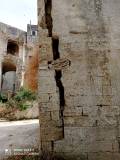REGENERATION OF THE PATHS FOR THE RUPESTRIAN AREA KNOWN AS “PIAGGIO”
Overlooking the Gravina torrent, the Piaggio district is the oldest in Gravina, in Apulia. Its redevelopment is an urban regeneration project that aims at restoring the accessibility and use of the Gravina, a barren place by nature, reshaped to capture water and find shelter. The reshaping of this land has led to the creation of terraces and neighbourhood orchards. For the past few decades, the district has been largely inaccessible: most of the roofs have collapsed, entire façades have detached from their buildings, the remaining structures are riddled with cracks and fractures.
[...]Read MoreREGENERATION OF THE PATHS FOR THE RUPESTRIAN AREA KNOWN AS “PIAGGIO”
Overlooking the Gravina torrent, the Piaggio district is the oldest in Gravina, in Apulia. Its redevelopment is an urban regeneration project that aims at restoring the accessibility and use of the Gravina, a barren place by nature, reshaped to capture water and find shelter. The reshaping of this land has led to the creation of terraces and neighbourhood orchards. For the past few decades, the district has been largely inaccessible: most of the roofs have collapsed, entire façades have detached from their buildings, the remaining structures are riddled with cracks and fractures.
Among the first interventions carried out, those related to cleaning and removal of vegetation have taken precedence, in order to perform the first survey activities. Moreover, in order to carry out an urban regeneration intervention, called Recupero dell’Animo Piaggiano Estinto, it was necessary to compile a careful analysis of the place of intervention, conducted on several fronts.
Knowing the history of the area, the alternation of stratifications and the succession of settlements allows to make the most appropriate design choices, in line with the land features of the area. Among the first design interventions, is the reconstruction of accessways, which will be evaluated in four different areas: paths for the disabled, driveways, pedestrian accesses in the internal streets, and pedestrian accesses along the perimeter. Currently, no space is directly accessible or useable, which is why the improvement project aims to expand usability and allow access to the churches of Santa Lucia and San Basilio. The beautiful scenery of the naturally formed rocky settlement allows the simultaneous enhancement of the individual caves and rock churches that have been built over time.
The paths, which will connect the historical centre to the surrounding natural landscape, have been made by recovering the ancient historical ones. The project, as a whole, aims at the requalification of the present paths without altering the state of the area or any of its slopes. Among its objectives, the project aims at converting the neighbourhood into a hub for culture and knowledge: therefore, plans included the installation of information devices through which visitors can read or listen to all the historical information, including the narration of scenes from the daily lives of people who lived on the district streets.
Great importance has been given to the securing of some unsafe buildings, that suffered critical damage and could face total collapse. It was necessary to intervene on the pavements, which is badly preserved, neglected and fragmented to this day.
strategic points, trying to frame landscape views of La Gravina, the Botromagno natural park and the rupestrian architectures.
In this regeneration project, plans have been made for the creation of a peripheral urban garden, on terrace, that will be known as the “Stone Garden”: it will contain numerous local tree species that are easy to maintain. The objective of this botanical project has multiple purposes: while maintaining the beauty given by the colours of plants, it will have the function of becoming an area for educational, recreational, therapeutic and ecological activities. A vital role is also played by the intervention on the central square, as a social gathering place, providing it with “smart” benches, made of local stone and equipped with wireless access points and beacons, charging points for electronic devices and speakers.
The signage will be an integral part of these paths: through this it will be possible to find information not only through the medium of written text, but also through the use of QR codes and beacons that, accessed via cell phone, can tell the story of the Piaggio district. Artistic works will be installed in the area to evoke the testimony of a place teeming with life.
The leitmotif of the project is water, which defines the “new urban landscape”: in fact, the interventions consist in repurposing of the historic cast iron fountain and locating other fountains in social gathering areas; other plans include the creation of a rainwater collection and irrigation system, and a wastewater treatment system, that would purify water for domestic or agricultural use.
The project also includes the consolidation, safety standards compliance and restoration of an important rocky complex in the Fondovico district, characterized by a series of non-covered arches: once belonged to a monastic complex, these arches need to be preserved and safeguarded, as relevant architectural artefacts that are considered an essential part of the San Michele delle Grotte rocky complex. Lastly, the final interventions focus on the repair and restoration of the wall face of the underground tunnel that runs along Via Piaggio, along with the resizing of the pure water treatment tank linked to the same tunnel.
Read Less


































